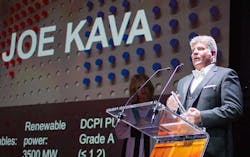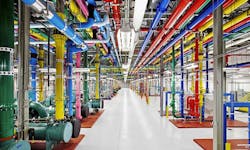Google’s Kava Looks to Take Data Center Sustainability to the Next Level
As he stood on stage in Monaco to accept a major industry award for data center sustainability, Joe Kava’s first thought was to share the honor with his entire team at Google. His second thought: Let’s take this to the next level.
That might be tricky, since Google now buys enough renewable energy to match 100 percent of its global annual electricity use – which is dominated by its mighty fleet of data centers, which power everything from YouTube videos to Gmail to every query you type into the search field.
But as he accepted the Infrastructure Masons 2019 Sustainability Champion award, Kava vowed that Google would continue to seek new ways to become even greener, and challenged the entire data center industry to join the effort.
“In 2017 we matched 100 percent of our data center consumption and Google enterprise consumption with renewable energy,” said Kava. “But we can do better. I’d like to challenge us, as an industry, to do even better. Our new commitment is to match (data center operations) hour for hour, 24 hours by seven days a week, with renewable energy. ”
Sustainability Meets the Bottom Line
The Infrastructure Masons is a professional association founded to “unite the builders of the digital age. The group was founded in 2016 by Uber executive Dean Nelson to chart a course for the fast-growing cloud economy. The group’s members have built more than $100 billion worth of data centers, and includes leaders of the infrastructure teams at Facebook, Microsoft, eBay, Switch and Google.
The iMasons launched the Sustainability Champion Award to recognize individuals who are “delivering extraordinary results with real impact on sustainability.”
“Sustainability is now a boardroom issue,” the iMasons said in announcing the award. “It impacts the bottom line and is good for business. As professionals in this industry and decision makers on investments and operations, we have a responsibility to drive a more efficient and sustainable future.”
Kava, who has led Google’s data center team for 11 years, certainly fits the bill. Under Kava’s leadership, Google has been a pioneer in greening the data center industry.
“This isn’t my work,” said Kava. “This is the work of all of our teams at Google that have been at this for more than a decade.” Here’s a video highlighting the Infrastructure Masons award and presentation. (Kava’s comments begin at about the 6:30 mark)
A Leader in Efficiency, Renewables
Sustainability has been a huge priority for Google, which has been a leader in two major phases of green innovation in the industry.
- In the first phase, Google dramatically improved the efficiency of its data centers, innovating in every aspect of operations, from the chips powering servers to the power infrastructure and cooling systems. Google’s relentless focus on efficiency yielded huge savings in electricity, slashing the amount of carbon needed to operate its Internet business. In 2009 Google began sharing its best practices, allowing others in the industry to improve their efficiency. Annual data center consumption increased by 90 percent from 2000 to 2005, but only by 4 percent from 2010 to 2014.
- In the second phase of its sustainability journey, Google’s data center team has focused on procuring renewable energy to power its operations instead of electricity sources based on coal. Google has signed 26 agreements totaling 3.5 gigawatts of renewable energy, an emissions savings equivalent to taking more than 1.3 million cars off the road per year. Google’s use of power purchase agreements (PPAs) for renewable energy has been adopted by other cloud providers and data center REITs.
Google’s new goal, announced in October 2018, is to use renewable energy to power every hour of operation of its data centers, around the clock and around the globe. Google can currently account for all its operations with energy purchases.
But the intermittent nature of renewable energy creates challenges in matching green power to IT operations around the clock. Solar power is only available during daylight hours. Wind energy can be used at night, but not when the wind dies down.
“That’s really almost impossible today,” said Kava. “There is new technology that has to be developed to enable this. But I think that we can do it, and we’ll be demonstrating and showing the industry how we can do this, and leading the way so that others can follow suit.”
Large pipes sporting Google’s logo colors move water throughout the cooling plant at the Google’ data center in Douglas County, Georgia. (Photo: Google)
The first step is being able to analyze the electricity powering the company’s 14 data center campuses on an hourly basis. Google has documented its effort in a discussion paper that shares location-specific “Carbon Heat Maps” to visualize how well a data center is matched with carbon-free energy on an hour-by-hour basis. The results vary widely in different regions. The heat map for Google’s data center campus in Hamina, Finland shows that 97 percent of the facility’s electricity use last year was matched with carbon-free sources. In Taiwan, the result was closer to 20 percent.
“Ultimately, we aspire to source carbon-free energy for our operations in all places, at all times,” said Michael Terrell, Head of Energy Market Development at Google. “The Carbon Heat Maps demonstrate that there are times and places where our electricity profile is not yet fully carbon-free. However, there is often not enough carbon-free energy available to match 100% of a data center’s hourly electric load in a given hour.”
Energy Storage: A Technology to Watch
“Meeting this challenge requires sourcing enough carbon-free energy to match our electricity consumption in all places, at all times,” said Terrell. “Such an approach looks markedly different from the status quo, which, despite our large-scale procurement of renewables, still involves carbon-based power.”
So what “new technology” is key to all-renewable, all-the-time operations? One possibility is better utility-scale energy storage, a topic that Kava has been thinking about for a long time.
“I think the tipping point for renewable swill be the next-generation of utility-scale energy storage,” Kava told Data Center Frontier in a 2015 interview. “As soon as real large-scale energy storage is available, I think that will bring more renewables in the grid. Renewables by nature are not base-load compatible, because they fluctuate. Large-scale storage could be tapped on a rainy or windy day. That’s going to be a key enabler. In the next five to 10 years, we’ll see some advancement in this area.”
Energy storage can address some of the intermittency challenges for wind and solar power. But it must be accompanied by changes in the way energy markets operate.
“Achieving 24×7 carbon-free energy will be no easy feat,” writes Terrell. “It will require innovations across policy, technology, and business models. We’ll need policy and market reforms that break down barriers to carbon-free energy procurement, as well as new policies that recognize the societal importance of carbon-free energy and appropriately price the attributes of different power sources. “
About the Author



